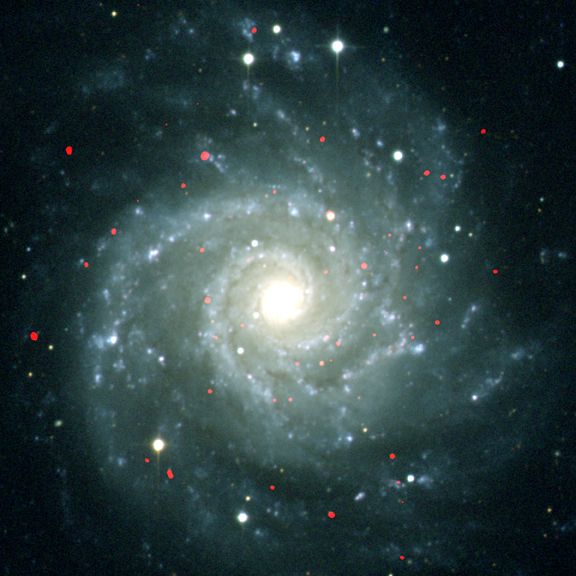
|
Credit & Copyright: X-ray;
J. Liu (U.Mich.)
et al.,
CXC,
NASA
-
Optical;
T. Boroson
(NOAO),
AURA,
NOAO,
NSF
Explanation:
In visual appearance, M74 is a
nearly perfect face-on spiral
galaxy, about 30 million light-years away toward the
constellation Pisces.
The red blotches seen in
this
composite view are ultraluminous
x-ray sources (ULXs) mapped by the
Chandra X-ray Observatory.
The ULXs are so called because they actually do radiate 10 to
1,000 times more x-ray power than "ordinary"
x-ray binary stars,
which harbor a neutron star or
stellar mass
black hole.
In fact,
watching
these ULXs change their
x-ray brightness over periods of 2 hours or so, astronomers
conclude that ULXs could well be
intermediate mass black holes --
black holes with
masses 10,000 times or so greater than the Sun, but still much less
than the million solar mass black holes which
lurk in the centers
of large spiral galaxies.
How did these intermediate mass black holes get there?
One intriguing suggestion is that they are left over from
the cores of much smaller galaxies that are
merging with
spiral galaxy M74.
|
January February March April May June July August September October November December |
| ||||||||||||||||||||||||||||||||||||||||||||||||
NASA Web Site Statements, Warnings, and Disclaimers
NASA Official: Jay Norris. Specific rights apply.
A service of: LHEA at NASA / GSFC
& Michigan Tech. U.
Based on Astronomy Picture
Of the Day
Publications with keywords: M 74 - spiral galaxy - black hole
Publications with words: M 74 - spiral galaxy - black hole
See also:
- APOD: 2025 December 3 Á Visualization: Near a Black Hole and Disk
- Portrait of NGC 1055
- APOD: 2025 September 24 Á GW250114: Rotating Black Holes Collide
- APOD: 2025 September 4 Á NGC 4565: Galaxy on Edge
- APOD: 2025 August 22 Á A Tale of Two Nebulae
- APOD: 2025 August 19 Á Giant Galaxies in Pavo
- APOD: 2025 August 18 Á NGC 1309: A Useful Spiral Galaxy
